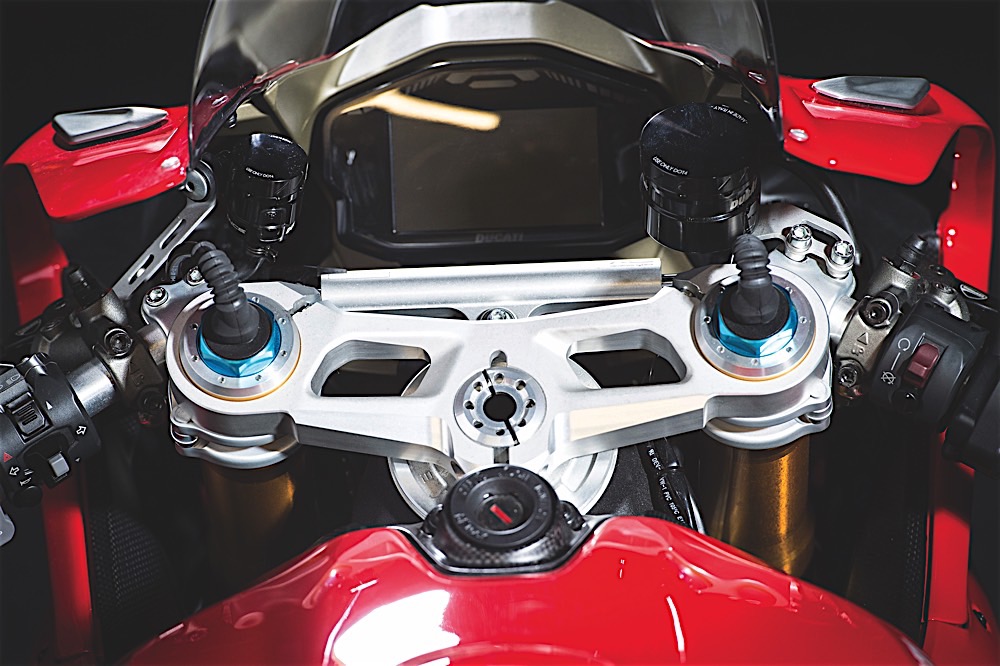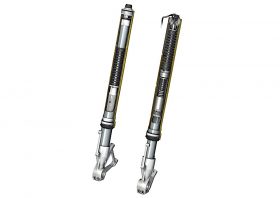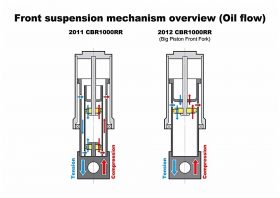The next step to better handling and a smoother ride.
In the previous issue, we discussed the damper-rod-type fork and its limitations, mostly caused by the fixed-diameter damping holes, which provide little damping when hitting small bumps and too much on large bumps. A cartridge fork, on the other hand, is designed to provide adequate damping over a wide variety of bumps by varying the damping rate depending on the speed at which the fork compresses. This allows damping oil flow to be more restricted over small bumps so the fork doesn’t feel mushy, while increasing oil flow on bigger bumps so it doesn’t feel harsh.
Cartridge Basics
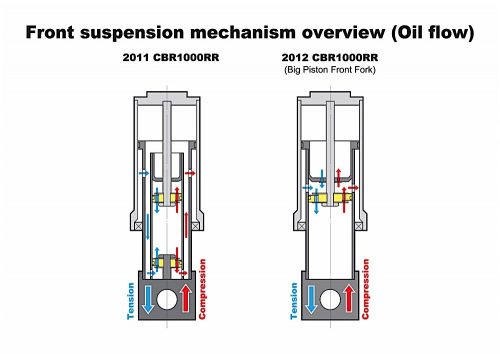
It does this by using what is essentially a shock absorber, located inside and at the bottom of the fork and submerged in oil. This “cartridge” consists of a small cylinder, in which two inline pistons slide up and down as the fork compresses and expands. The pistons are attached to the end of a long rod that attaches to the part of the fork secured in the triple clamps, while the cylinder is connected to the part of the fork attached to the wheel. I did not get specific about fork tubes, male sliders or female sliders because cartridge forks are available in both traditional and inverted forks.
It is these pistons that control the damping: one on compression, the other on rebound. These pistons have a series of passages drilled into them, in line with the fork travel. These passages are covered with a series, or “stack,” of flexible washers, or shims. As the fork compresses, oil is forced through the passages, which, if unrestricted, would function exactly like the holes in a damper-rod fork. It’s the flexible shims, which act very much like reed valves, that vary the damping rate, flexing just a bit over small bumps to let a little oil flow through the holes to control low-speed bouncing, and flexing a lot over large bumps, freeing up oil flow and softening fork action.
Adjustable Cartridges
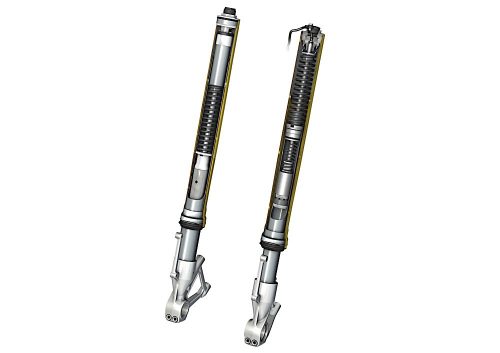 On an adjustable fork, the pistons – on either rebound, or rebound and compression – contain small secondary passages, into which a tapered needle is inserted. These needle valves are attached to the external adjusters, which when turned in, push the needles farther into the secondary passages, restricting oil flow and increasing the damping rate; when turned out, they retract the needles, increasing oil flow and reducing the damping rate.
On an adjustable fork, the pistons – on either rebound, or rebound and compression – contain small secondary passages, into which a tapered needle is inserted. These needle valves are attached to the external adjusters, which when turned in, push the needles farther into the secondary passages, restricting oil flow and increasing the damping rate; when turned out, they retract the needles, increasing oil flow and reducing the damping rate.
A cartridge fork, even if it has no external adjusters, is nonetheless much more tuneable than a damper-rod fork. When a cartridge fork is brought to a race shop to be “re-valved,” what the fork tuner is doing is disassembling the fork and readjusting the shim stack, by either removing or adding shims or varying their thickness, to alter the damping rate based on experience gathered through testing. A fork specialist will also experiment with different fork oil thicknesses, just as in a damper-rod fork, though just as with a damper-rod fork, altering the oil level will only change the spring rate.
Not All Forks are Equal
A cartridge fork also opens up the possibilities to motorcycle manufacturers to experiment with different setups, like using one fork to control rebound damping and the other to control compression damping. Some bike makers have even resorted to controlling all the damping in one fork, using the other only to keep the front wheel in line.
More recently, suspension maker Showa introduced the Big Piston Fork, or BPF. The BPF functions like a normal cartridge fork, but without the cartridge. Instead of using a separate cylinder inserted into the fork, Showa uses the fork itself as the cylinder, with a much larger piston that provides both rebound and compression damping duties. This larger piston allows more oil to flow through it, which greatly improves damping control over smaller bumps, while the shim stack still allows the fork to perform very well on bigger bumps. It also allows for a greater range of damping adjustability. The lack of a separate cylinder at the bottom of the fork also reduces unsprung weight, which further reduces suspension harshness.
High-End Coatings
Because cartridge forks are mostly used on expensive supersport machines, other harshness-reducing technology may also be used on a cartridge fork, like friction-reducing coatings such as titanium nitride or diamond-like carbon (DLC). Titanium nitride is gold in colour, while DLC is black. They are both very thin coatings applied to the female slider; DLC coating is harder than the former, and both are harder and thinner than chrome.
Friction between the male and female sliders has always been a problem with fork manufacturing, and it is the main cause of harshness over small bumps. Because it takes a certain amount of pressure to get a sticky fork to telescope, it is essentially rigid over small bumps, transmitting an unpleasant jolt through the handlebar. Both these coatings reduce this tendency, but add cost, which is why they are never used on basic damper-rod forks.
Technical articles are written purely as reference only and your motorcycle may require different procedures. You should be mechanically inclined to carry out your own maintenance and we recommend you contact your mechanic prior to performing any type of work on your bike.









